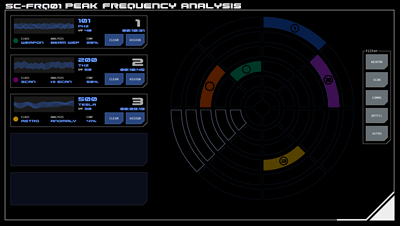

Sensor Systems

Sensor systems are used to provide analysis of the ship's operating environment. Effectively the the vessel's eyes and ears, sensory systems are vital to core operations.
Applications
Sensor systems are used across a range of key vessel systems including:
Helm
Sensor systems are used to fix the vessel's position in space in order to ensure effective navigation
Tactical
Passive sensor systems are used to determine the location and range of tactically-significant objects around the vessel and to assist the targeting and deployment of weapons and countermeasures.
Analysis
Active sensor systems are used to provide detailed analysis of objects encountered in space such as other vessels.
Exploration
A range of sensor systems including drones are used to analyse spatial and planetary phenomenon for scientific advancement and to potentially assist in the search for first contact with other civilisations.
Long-Range Sensors
Long range sensors are used to analyse distant stellar phenomenon and to support navigation. Long-range sensors primarily use radio telescope equipment.
Near-Range Sensors
Near-range sensors use a range of passive and active equipment to analyse the vessel's immediate operating environment within star systems. This typically includes other vessels or smaller Astronomical Objects (AOs) or phenomenon. When the vessel's on-board sensors are augmented by drones, larger objects such as planets can also be mapped.
Passive Systems
Passive sensor systems detect EM radiation emitted by other vessels, Astronomical Objects (AOs) or phenomenon.
Analysis of the detected EM can provide insights into its origin or purpose (for example whether the EM is for communications, scanning or tactical purposes).
Passive sensors have the advantage of not requiring the emission of any EM (as is required for active scans) which minimises the chances of being detected by another vessel, which is highly useful in tactical applications.
Passive systems also typically operate at much longer ranges than active systems.
EMDAR
EMDAR is used for the initial detection of objects in space. EMDAR is primarily a tactical system although once an object is tracked by the system analysis of its EM emissions can provide additional insights well before active systems can be effective.
Peak Frequency Analysis (PFA)
Peak Frequency Analysis (PFA) provides a detailed analysis of EM detected closer to the vessel. This analysis can provide guidance on the direction of the EM source as well the extent to which the EM may have been targeted at the vessel.
(PFA) provides a detailed analysis of EM detected closer to the vessel. This analysis can provide guidance on the direction of the EM source as well the extent to which the EM may have been targeted at the vessel.
The frequency distribution and amplitude within the detected EM can provide insights into its purpose, for example whether it is for communications (and the type of communications), scanning or tactical purposes.
Active Systems
Active sensor systems emit EM (as a scan) and analyse its reflection, diffraction or absorption to build a 3D visualisation of the object and form conclusions about its composition.
Different active sensor types provide different levels of information and are typically grouped into two major categories, depending on the frequency and/or intensity of the scans required.
Low Power Active Systems
Low power systems use lower frequency EM (typically within the radio and infrared spectrum bands).
Simple Location/Identification Scans
A Simple Location/Identification (SLI or 'sly') active scan is used to identify the location of non-AO objects within range of the scanning vessel (up to 3000 GUs). A list of objects of interest is displayed which can then be targeted by the operator for further scanning and/or tracking.
Spectral Composition Analysis (SCA)
Spectral Composition Analysis  (SCA) uses the same low frequency EM scans for longer periods to build a 3D visualisation of the object. Analysis of the reflection, diffraction and absorption of the scan is used to assess the composition of the scanned object.
(SCA) uses the same low frequency EM scans for longer periods to build a 3D visualisation of the object. Analysis of the reflection, diffraction and absorption of the scan is used to assess the composition of the scanned object.
The system can typically determine the material type (metallic, mineral, organic, gaseous, liquid) and key datapoints such as density, temperature and even component elements.
Once a SCA scan has been completed to a minimum fidelity it is possible to overlay the approximate location of EM output onto the object to assist with analysis.
High Power Active Systems
High power systems use higher frequency EM (typically within the ultraviolet and ionising spectrum bands) to provide analysis if the interior of objects. The frequencies used by higher power systems makes it more likely that a scan might be mistaken for hostile activity such as weapons fire.
Spectroscopic Structural Analysis (SSA)
Spectroscopic Structural Analysis (SSA) utilises higher frequency scans to penetrate the exterior of the scanned object and provide insights into the object's interior.
The relative density of materials encountered by the scan as it penetrates through the object can indicate whether the object has interior spaces, wether those spaces have an atmosphere of some kind and whether organic objects of any significant size (such as lifeforms) are present. AI-assisted analysis is used to provide insights to the operator on the interior composition of the scanned object.








